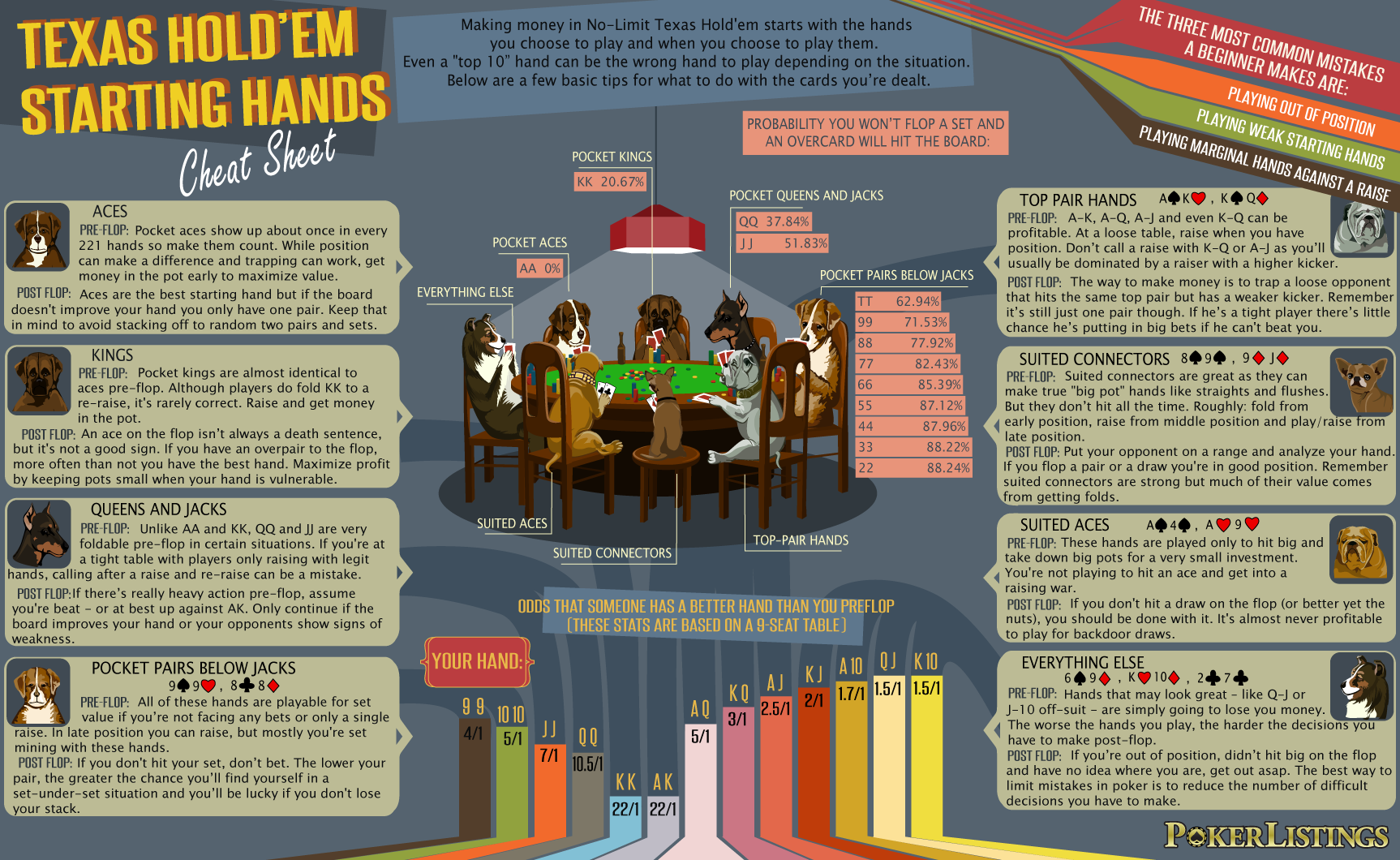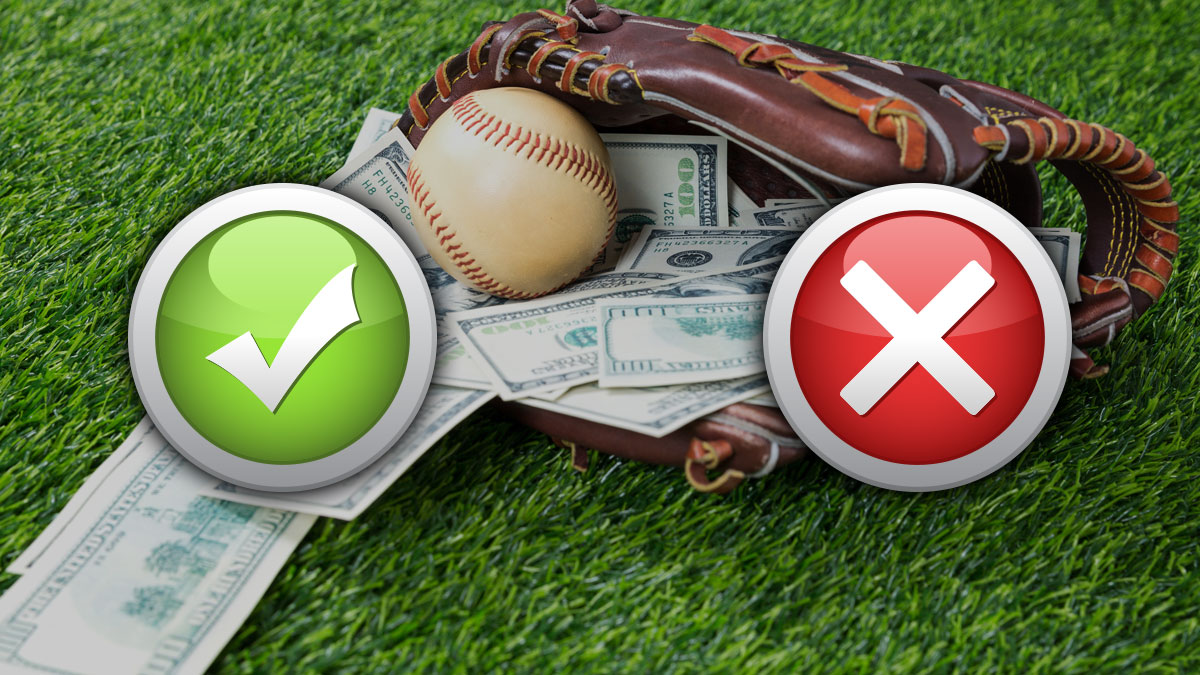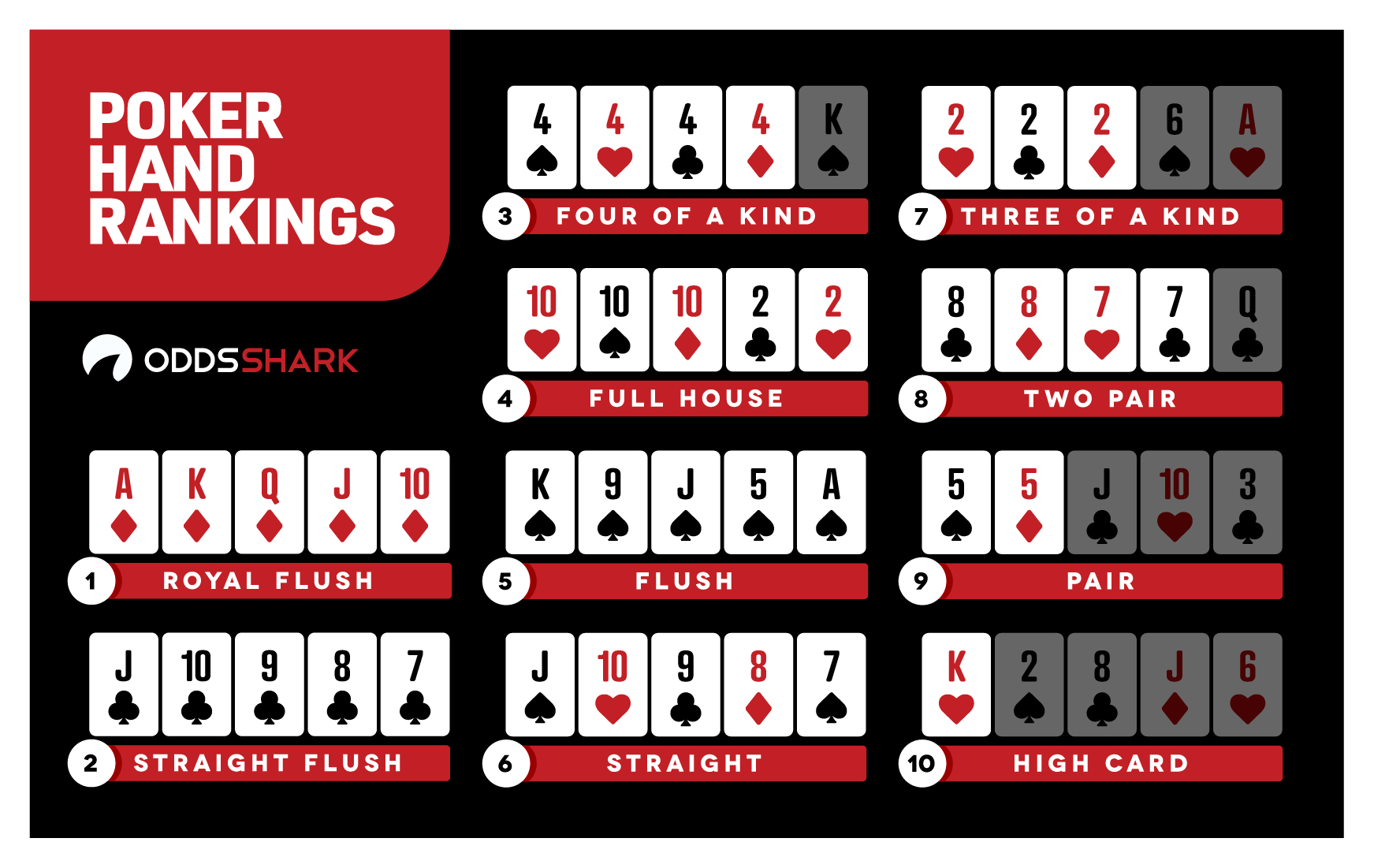Best Possible Hand In Texas Holdem
With only ten possible outcomes for a poker hand, it is of course possible that the best hand at the table (a pair of 9s, for example) will be held by more than one player. In this case, the tie is.
- Best Possible Hand In Texas Holdem Tournament
- Best Hands In Texas Holdem Ranked
- Texas Holdem Hands Printable
- Best Statistical Hand In Texas Holdem
- Texas Holdem Hand Rankings Preflop
Every poker player on the planet has been there before. You’ve been playing tight and grinding up a stack, patiently awaiting your opportunity to punish the table with pocket Aces – the best possible starting hand in no limit Texas holdem.
- Below you'll find a list of Texas Hold'em starting hands organized by relative strength.The following charts contains every 2-card possible combination you can be dealt in Texas Hold'em. Each hand is followed by its long-term winning percentage (out of 100, of course) against a specific number of opponents holding random cards.
- Each Texas holdem hand starts with the first two seats posting the small and big blinds, which are forced bets to create a pot. The small blind is equal to one half of the big blind, and blinds rotate one spot to the left with each new hand. Players are then dealt two face down cards a.k.a. Hole cards to form their starting hand.
Even if you’re a decorated poker pro, finally looking down to find A-A in the hole is enough to cause goose bumps and immediate increase in your heartbeat.
After all, pocket Aces will always have any hand your opponent(s) potentially hold – except for another pair of Aces of course – completely and utterly dominated. All it takes now is a clean community card board to avoid the dreaded “bad beat” and you’re in the clear to claim a sizable stack of chips.
Unfortunately, navigating the flop, turn, and river to reach a showdown with pocket Aces still in the lead is easier said than done. no limit Texas holdem is a poker variant built on volatility and variance, so all it takes is the wrong runout to wreck your pocket Aces plan in a hurry.
The “Godfather of Poker” himself – 10-time World Series of Poker (WSOP) gold bracelet winning champion Doyle Brunson – knew this lesson well when he wrote his seminal strategy book “Super / System: A Course in Power Poker” in 1978. As Brunson put it way back then, holding pocket Aces is almost a recipe for either one of two likely outcomes:
“The fact is, with a pair of Aces … One of two things will usually happen.
Either (1) you’ll win a small pot, or (2) you’ll lose a big pot.”

For that reason, Brunson advised readers of his “Super / System” to take an aggressive approach before the flop whenever they’re lucky enough to squeeze that beautiful A-A. To his thinking, it’s far more favorable to drag a small pot when the alternative is losing your entire stack courtesy of a bad beat.
Whether you agree with Brunson’s advice is a matter of personal perception of course, and indeed, many players like to “slow play” their pocket Aces instead. Slow-playing simply refers to taking a passive line when holding a monster hand, so these folks will check and flat call rather than raise in hopes of trapping an unwitting opponent into overplaying a beaten hand.
Unfortunately, beginners who are taking up no limit Texas holdem for the first time are often inundated with unsolicited advice from more experienced players purporting to know the “right” way to play A-A. Spend enough time at a Las Vegas poker table, and you’ll invariably hear the regulars regale rookies with ironclad rules on the best way to deploy pocket aces:
“You should ALWAYS be raising the Ace-Ace kid, because when you’re up against two or three hands, you’re actually a favorite to lose by the river.”
“For my money, I’ll NEVER limp into the pot with pocket Aces, that’s a fool’s errand that paves the path to bad beat city.”
“The best players here learned long ago that the flushes and straights ALWAYS flop after you slow-play the Aces.”
Naturally, binary “this way or the highway” rules like this can never be effective within a fluid strategy game like no limit Texas holdem. The list of variables that should be taken into account before deciding on the correct course of action is a long one, including factors like stack sizing, table position, physical tells from an opponent, blind level (in the tournament setting), and one’s personal tolerance for risk.
Earlier on I decided to tackle one side of the most prevalent “rule” concerning pocket Aces, so I examined five reasons why you should always* raise preflop and play aggressively when holding A-A. To finish this thought experiment off, I’d like to shift the focus to the other side of the coin, so this page is devoted to five reasons why you should never* raise preflop when you have “American Airlines” in hand.
*Obviously, rules advising anyone to “never” or “always” adopt a certain strategy are defective by nature. no limit Texas holdem strategies should be flexible and fluid based on variables unique to that particular hand and situation. But the five reasons found below do explore reasons into why playing pocket Aces aggressively preflop is preferable to a slow-play approach.
1 – Odds of Getting Pocket Aces Are 1/220
With 52 cards in the deck, 13 unique ranks from 2 through Ace, and only two hole cards to a hand, your odds of catching pocket Aces stand at 1 in every 220 deals.
Those odds hold true for all pocket pairs for that matter, but if you’re hoping to land the best starting hand in the game, you can expect to do so roughly one-half of one percent of the time.
And remember, those are simply the theoretical odds based on long-term statistical probability…
In the real world setting, poker players can easily suffer through droughts lasting 300, 400, or even more hands without every setting eyes on pocket Aces.
With that in mind, you’ve got to ask yourself one thing – do you really want to waste such a rare opportunity by raising with reckless abandon?
Let’s say you’re playing in a $2/$5 no limit holdem cash game and you’re treading water up until you snag the Ace of hearts and the Ace of diamonds. Blessed with the prettiest hand in all of poker, and hoping to reap the rewards, you respond to an opponent’s $15 open by re-raising to a hefty $75.
This aggression sends the signal that you’re quite strong here, so the rest of the table folds around in short order. No bother though, you have your sights set solely on the original raiser’s $500 stack.
But when the action moves back to him, the opener simply smirks and says “nice hand, Aces, Kings, or Queens all have me beat so I’m out” before tossing pocket Jacks face up to the dealer. Just like that, a juicy spot in which you held A-A against a dominated J-J results in a middling $20 profit – and not the $500 uptick you were expecting to enjoy.
In a parallel poker universe, however, another version of you decided to simply flat call the first $15 raise. From there, the flop came down harmlessly showing 10-4-2, giving your opponent the impression he held the best hand with his over-pair to the board. A raising war ensues, and soon enough you have $1,000 in the pot with more than 91 percent equity thanks to your Aces beating their Jacks.
Unless you’re prepared to drag a series of tiny pots because your aggression folded potential second-best hands out preflop, limping in or flat calling opening raises is the best way to maximize your profit margin with pocket Aces.
2 – Play Passively to Disguise Your Pocket Aces
As the second example up above made clear, choosing to slow-play pocket Aces before the flop is a great way to trick your opponent(s) into thinking you have a marginal hand.
After all, the “book” does say that optimal strategy involves raising to thin the herd when you hold a monster. Therefore, watching somebody put in the minimum amount of chips to proceed is usually a telltale sign that they’re speculating with suited connectors, small pocket pairs, or unpaired “Broadway” cards (10, Jack, Queen, King, or Ace).
Conversely, putting in a big raise or re-raising the opener helps opponents to narrow down your potential holdings to the premium starting hands.
Best Possible Hand In Texas Holdem Tournament
Mixing it up by playing “in reverse” – or slow-playing your strong hands and going aggressive with weaker holdings – is part and parcel of higher-level poker strategy.
3 – “Aces-Cracking” Hands Are Still Huge Underdogs
Decades of poker experience has shown many regulars that the best way to topple pocket aces is to play suited connectors.
Forever, the poker community believed Jack-10 suited to be the best “Aces-cracker” in the game, thanks in large part to the abundance of flush and nut straight possibilities the hand provides. And indeed, J-10 suited does give your opponent a 21.55 percent chance to wind up with the winner at showdown.
Best Hands In Texas Holdem Ranked
Nonetheless, that means you’ll still win the pot roughly 4 times for every 5 confrontations between A-A and J-10 suited. A nearly 80 percent win rate is nothing to sneeze at, so you shouldn’t let the fear of losing once in five tries dissuade you from trapping draw-heavy hands like J-10 suited.
And the news is even better when you’re up against other playable hands like smaller pocket pairs (80.93 percent win rate) and Ace-King (91.95 percent). Knowing these numbers should help make slow-playing pocket Aces preflop much more palatable for risk-averse players.
Sure, you’ll suffer the occasional bad beat, but you’ll wind up with the winner much more often than not.
4 – Allow an Opponent Into the Hand
The case of “big slick,” or the Ace-King holding, is a perfect example to show why slow-playing pocket Aces really works.
If you let your opponent see a flop with A-K and they catch an Ace or a King, they’ll be absolutely delighted to have top-pair + top-kicker on their side. In almost every other case, flopping top-pair + top-kicker is a goldmine, as the A-K will be far out in front of weaker Aces and other dominated hands.
Texas Holdem Hands Printable


By raising aggressively preflop, and sending a signal that their big slick might be up against “pocket rockets,” all you’re doing is scaring off a potential second-best hand that would’ve been happy to get their entire stack all in.
5 – Slow-Playing Aces Will Disorient Opponents
Once you’ve successfully employed a slow-play of pocket Aces, just look at your fellow player’s faces when you show down your cards.

They’ll be stunned and astonished… then they’ll be suspicious. Going forward, any hand you happen to limp in or flat call with could very well be a repeat, so they’ll be wary that you’re trying to trick them with A-A once again.
This hesitance on their part can provide a tremendous advantage for thinking players, as you’ll then be capable of exploiting their doubts by widening your own range of playable hands.
Best Statistical Hand In Texas Holdem
Any chance you get to disorient opponents at the poker table is extremely valuable, and slow-playing with pocket Aces is the ultimate form of subterfuge when playing real money Texas Holdem.
Texas Holdem Hand Rankings Preflop
Conclusion
Pocket Aces can be a devilish hand to play simply based on the expectations you’ll have upon squeezing that perfect pair. Knowing you have the early advantage over the table can be intoxicating, but if you’re not careful, the A-A can cause you to play an overly cautious game. Choosing to always raise with the best starting hand in Texas holdem might have its merits, but so does taking the slow road and slow-playing pocket Aces to set yourself up for a massive pot.